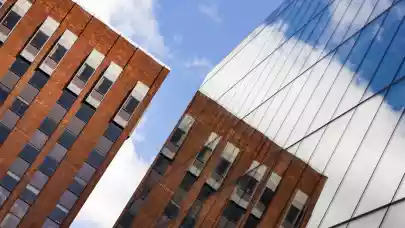
An increasing number of value-add investment opportunities will emerge in 2022, said Savills, as decarbonising buildings and ESG-requirements create redevelopment opportunities across Europe.
The international real estate advisor said that the risk of stranded assets was rising because occupiers were demanding buildings with high environmental credentials and that this would be an opportunity for investors prepared to undertake retrofitting and refurbishment.
In its European Themes 2022 report, Savills said that regulations and planning policies will force a shift in focus from new office development to renovation to avoid the embodied carbon emissions associated with construction.
Meanwhile, the real estate industry will be looking to measure the carbon footprint of assets to identify underperforming buildings and improve energy performance as it makes net zero “a priority”.
Katarzyna Chwalbińska-Kusek, ESG & Sustainability Lead at Savills in Poland, said: “Net-zero emissions are the key sustainability requirement on the European commercial property market. Investment funds and international tenants expect low emissions and plans for achieving them in Poland too. We are already seeing how asset portfolios and the availability of financing for non-ESG compliant real estate are changing. We are now on the brink of a major transformation. Reducing our emissions and carbon footprint is key to ESG policies and should be an inherent part of any real estate strategy. It is therefore advisable that investors and asset managers measure the carbon footprint of their buildings and assess the climate risk of new acquisitions. Looking ahead, building a competitive edge in real estate will largely require implementing climate tech solutions.”
Savills said that these trends would bring value-add opportunities with good rental uplift potential.
By the end of 2021, secondary yields had already moved out in the UK and the Netherlands, where environmental regulations are being introduced. At the year-end, the yield gap between prime and secondary office assets closed at 77bps. Historically, the interest of value-add investors rises once the yield gap is above 90bps.
Savills expects the widening gap to feature across Europe, where one area of opportunity will be the need to improve the performance of operational real estate.
Life science facilities in research and development hubs; student housing in large university cities with a low supply of professionally managed student accommodation; care homes and hospitals; data centres; prime retail parks and hospitality in established tourist destinations were also among Savills’ top value-add investment picks.
Multifamily development in partnership with local developers in secondary cities in countries with strong regional urban centres will also be among the areas of interest for opportunistic investors, said Savills, as well as logistics development in countries with lower but fast-growing e-commerce penetration; corporate warehouses; well-connected retail centres in need of active asset management; and eco-friendly hospitality developments focussed on wellbeing.
Savills anticipates that the rise of Omicron will have a more modest impact on the office occupier market than during 2020/21, with businesses now better prepared for Covid-19.
Offices in prime locations with good transport links and strong EPC ratings would be where occupier demand would be strongest.
Chris Gillum, Head of Offices, Regional Investment Advisory, Savills said: “For older office buildings in fringe locations, we expect landlords to spend more on refurbishments to avoid obsolescence, although an increase in secondary vacancy rates is to be expected in 2022 as prime/secondary rents begin to diverge. Flexibility will become more essential for occupiers’ return to work strategies, centred around collaboration, creativity, and engagement. Many companies will remain unable to plan for longer lease periods and we expect larger corporates to be increasing their exposure to the flex office market. Flex accounted for a record 9% of Europe’s office demand in 2019, and we anticipate a recovery towards this level in 2022.”



